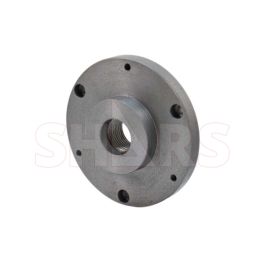- Joined
- Dec 25, 2023
- Messages
- 94
I've been tinkering and collecting tooling and parts for this old 1942 SB Heavy 10 (the 10R, cat.199-Y), and using the Grizzly 14x48 here at work, I finally made some parts to get stuff done at home.
First is a back plate, to go with the "chinesium" 3-jaw chuck I received courtesy of @Nesse1 . It's ugly for now, but I'll soon carve it into a more reasonable semblance of round. I'm sorry I didn't take any pics of the nut before I pressed it into the plate, but it came from McMaster-Carr at almost 1.5" thick! I used the lathe at work to part it off to 1.25", faced it, cut a register on the original side, and then turned 1" of it down to 2.25".
I chucked the round-esque slab of 1x8" HRS in the 3-jaw and center-drilled and bored it to match (a couple thousands undersize), and used the hydraulic press to put the two together. I need to work on my shoulder turn transition, as you can see a slight gap between the nut shoulder and the plate in the second pic. I did also weld the face side of it, but I don't have a good pic of that.
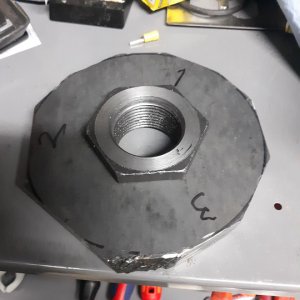
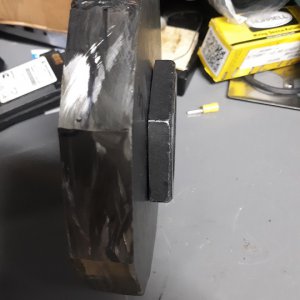
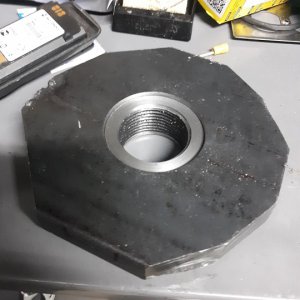
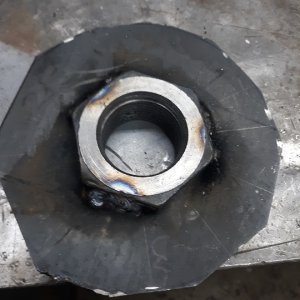
I really need to face and turn this in the SB, so it's correct to my specs, but my toolpost is broken! What to do? Go back to work!
(The lantern toolpost I got on ebay came with a crack in the base I didn't see, which finally gave up the ghost while trying to work on the nut that goes to that backplate above, which is why I finished it at work. Couldn't figure why my tool holder kept backing out! Apparently, this is a common problem due to monkey-fisted operators, I've seen a lot of them on ebay with bowed or already-cracked bases.)
In order to be able to turn that backplate at home, I made a new toolpost base. And if I need to make another one, I have another 4 or 5 inches of stock to carve up! I'll upgrade to a turret or AXA eventually, but for now the lantern suits me fine.
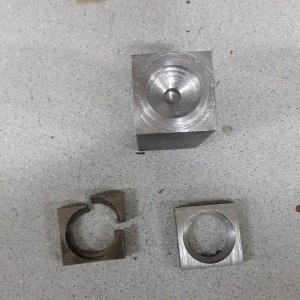
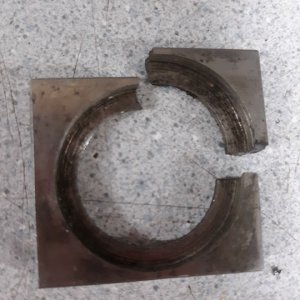
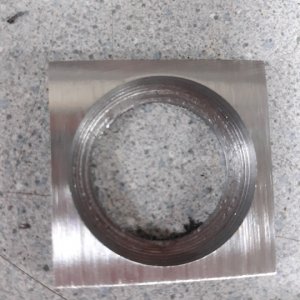
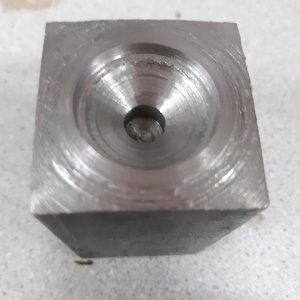
So now I can put tool to faceplate and make a mess in the basement. Once the plate is turned and the chuck mounted, my next project is taking a chunk of cutoff plastic bushing material from work and practice internal and external threading, so I can eventually make a "real" backplate. I also rescued some cutoffs of keyway shafting from work, which I plan to use to make a replacement gib screw for the crossfeed- some PO took it out and must have lost it, and replaced it with a SHCS and washer, which doesn't capture the gib well at all.
Oh! And somewhere in all this, I also plan to finally do my 12" bar and two-collar tests... <rolleyes>
First is a back plate, to go with the "chinesium" 3-jaw chuck I received courtesy of @Nesse1 . It's ugly for now, but I'll soon carve it into a more reasonable semblance of round. I'm sorry I didn't take any pics of the nut before I pressed it into the plate, but it came from McMaster-Carr at almost 1.5" thick! I used the lathe at work to part it off to 1.25", faced it, cut a register on the original side, and then turned 1" of it down to 2.25".
I chucked the round-esque slab of 1x8" HRS in the 3-jaw and center-drilled and bored it to match (a couple thousands undersize), and used the hydraulic press to put the two together. I need to work on my shoulder turn transition, as you can see a slight gap between the nut shoulder and the plate in the second pic. I did also weld the face side of it, but I don't have a good pic of that.




I really need to face and turn this in the SB, so it's correct to my specs, but my toolpost is broken! What to do? Go back to work!
(The lantern toolpost I got on ebay came with a crack in the base I didn't see, which finally gave up the ghost while trying to work on the nut that goes to that backplate above, which is why I finished it at work. Couldn't figure why my tool holder kept backing out! Apparently, this is a common problem due to monkey-fisted operators, I've seen a lot of them on ebay with bowed or already-cracked bases.)
In order to be able to turn that backplate at home, I made a new toolpost base. And if I need to make another one, I have another 4 or 5 inches of stock to carve up! I'll upgrade to a turret or AXA eventually, but for now the lantern suits me fine.




So now I can put tool to faceplate and make a mess in the basement. Once the plate is turned and the chuck mounted, my next project is taking a chunk of cutoff plastic bushing material from work and practice internal and external threading, so I can eventually make a "real" backplate. I also rescued some cutoffs of keyway shafting from work, which I plan to use to make a replacement gib screw for the crossfeed- some PO took it out and must have lost it, and replaced it with a SHCS and washer, which doesn't capture the gib well at all.
Oh! And somewhere in all this, I also plan to finally do my 12" bar and two-collar tests... <rolleyes>


